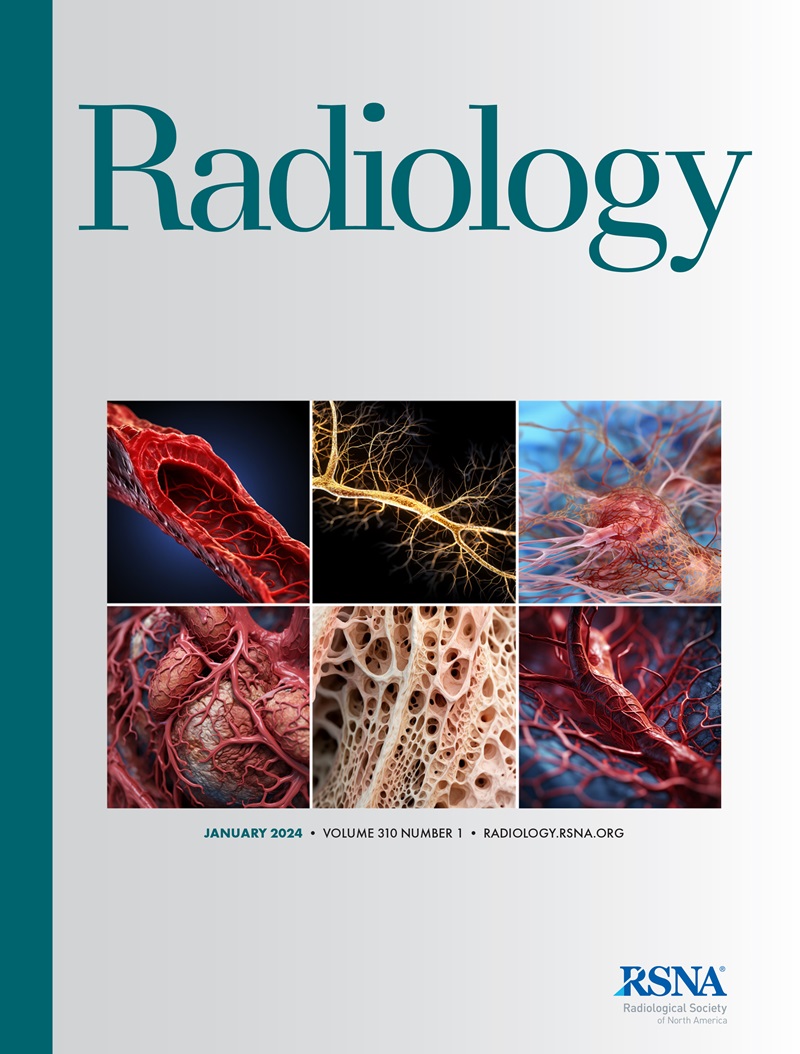下载PDF
{"title":"全自动深度学习模型在核磁共振成像中检测具有临床意义的前列腺癌。","authors":"Jason C Cai, Hirotsugu Nakai, Shiba Kuanar, Adam T Froemming, Candice W Bolan, Akira Kawashima, Hiroaki Takahashi, Lance A Mynderse, Chandler D Dora, Mitchell R Humphreys, Panagiotis Korfiatis, Pouria Rouzrokh, Alexander K Bratt, Gian Marco Conte, Bradley J Erickson, Naoki Takahashi","doi":"10.1148/radiol.232635","DOIUrl":null,"url":null,"abstract":"<p><p>Background Multiparametric MRI can help identify clinically significant prostate cancer (csPCa) (Gleason score ≥7) but is limited by reader experience and interobserver variability. In contrast, deep learning (DL) produces deterministic outputs. Purpose To develop a DL model to predict the presence of csPCa by using patient-level labels without information about tumor location and to compare its performance with that of radiologists. Materials and Methods Data from patients without known csPCa who underwent MRI from January 2017 to December 2019 at one of multiple sites of a single academic institution were retrospectively reviewed. A convolutional neural network was trained to predict csPCa from T2-weighted images, diffusion-weighted images, apparent diffusion coefficient maps, and T1-weighted contrast-enhanced images. The reference standard was pathologic diagnosis. Radiologist performance was evaluated as follows: Radiology reports were used for the internal test set, and four radiologists' PI-RADS ratings were used for the external (ProstateX) test set. The performance was compared using areas under the receiver operating characteristic curves (AUCs) and the DeLong test. Gradient-weighted class activation maps (Grad-CAMs) were used to show tumor localization. Results Among 5735 examinations in 5215 patients (mean age, 66 years ± 8 [SD]; all male), 1514 examinations (1454 patients) showed csPCa. In the internal test set (400 examinations), the AUC was 0.89 and 0.89 for the DL classifier and radiologists, respectively (<i>P</i> = .88). In the external test set (204 examinations), the AUC was 0.86 and 0.84 for the DL classifier and radiologists, respectively (<i>P</i> = .68). DL classifier plus radiologists had an AUC of 0.89 (<i>P</i> < .001). Grad-CAMs demonstrated activation over the csPCa lesion in 35 of 38 and 56 of 58 true-positive examinations in internal and external test sets, respectively. Conclusion The performance of a DL model was not different from that of radiologists in the detection of csPCa at MRI, and Grad-CAMs localized the tumor. © RSNA, 2024 <i>Supplemental material is available for this article.</i> See also the editorial by Johnson and Chandarana in this issue.</p>","PeriodicalId":20896,"journal":{"name":"Radiology","volume":null,"pages":null},"PeriodicalIF":12.1000,"publicationDate":"2024-08-01","publicationTypes":"Journal Article","fieldsOfStudy":null,"isOpenAccess":false,"openAccessPdf":"https://www.ncbi.nlm.nih.gov/pmc/articles/PMC11366675/pdf/","citationCount":"0","resultStr":"{\"title\":\"Fully Automated Deep Learning Model to Detect Clinically Significant Prostate Cancer at MRI.\",\"authors\":\"Jason C Cai, Hirotsugu Nakai, Shiba Kuanar, Adam T Froemming, Candice W Bolan, Akira Kawashima, Hiroaki Takahashi, Lance A Mynderse, Chandler D Dora, Mitchell R Humphreys, Panagiotis Korfiatis, Pouria Rouzrokh, Alexander K Bratt, Gian Marco Conte, Bradley J Erickson, Naoki Takahashi\",\"doi\":\"10.1148/radiol.232635\",\"DOIUrl\":null,\"url\":null,\"abstract\":\"<p><p>Background Multiparametric MRI can help identify clinically significant prostate cancer (csPCa) (Gleason score ≥7) but is limited by reader experience and interobserver variability. In contrast, deep learning (DL) produces deterministic outputs. Purpose To develop a DL model to predict the presence of csPCa by using patient-level labels without information about tumor location and to compare its performance with that of radiologists. Materials and Methods Data from patients without known csPCa who underwent MRI from January 2017 to December 2019 at one of multiple sites of a single academic institution were retrospectively reviewed. A convolutional neural network was trained to predict csPCa from T2-weighted images, diffusion-weighted images, apparent diffusion coefficient maps, and T1-weighted contrast-enhanced images. The reference standard was pathologic diagnosis. Radiologist performance was evaluated as follows: Radiology reports were used for the internal test set, and four radiologists' PI-RADS ratings were used for the external (ProstateX) test set. The performance was compared using areas under the receiver operating characteristic curves (AUCs) and the DeLong test. Gradient-weighted class activation maps (Grad-CAMs) were used to show tumor localization. Results Among 5735 examinations in 5215 patients (mean age, 66 years ± 8 [SD]; all male), 1514 examinations (1454 patients) showed csPCa. In the internal test set (400 examinations), the AUC was 0.89 and 0.89 for the DL classifier and radiologists, respectively (<i>P</i> = .88). In the external test set (204 examinations), the AUC was 0.86 and 0.84 for the DL classifier and radiologists, respectively (<i>P</i> = .68). DL classifier plus radiologists had an AUC of 0.89 (<i>P</i> < .001). Grad-CAMs demonstrated activation over the csPCa lesion in 35 of 38 and 56 of 58 true-positive examinations in internal and external test sets, respectively. Conclusion The performance of a DL model was not different from that of radiologists in the detection of csPCa at MRI, and Grad-CAMs localized the tumor. © RSNA, 2024 <i>Supplemental material is available for this article.</i> See also the editorial by Johnson and Chandarana in this issue.</p>\",\"PeriodicalId\":20896,\"journal\":{\"name\":\"Radiology\",\"volume\":null,\"pages\":null},\"PeriodicalIF\":12.1000,\"publicationDate\":\"2024-08-01\",\"publicationTypes\":\"Journal Article\",\"fieldsOfStudy\":null,\"isOpenAccess\":false,\"openAccessPdf\":\"https://www.ncbi.nlm.nih.gov/pmc/articles/PMC11366675/pdf/\",\"citationCount\":\"0\",\"resultStr\":null,\"platform\":\"Semanticscholar\",\"paperid\":null,\"PeriodicalName\":\"Radiology\",\"FirstCategoryId\":\"3\",\"ListUrlMain\":\"https://doi.org/10.1148/radiol.232635\",\"RegionNum\":1,\"RegionCategory\":\"医学\",\"ArticlePicture\":[],\"TitleCN\":null,\"AbstractTextCN\":null,\"PMCID\":null,\"EPubDate\":\"\",\"PubModel\":\"\",\"JCR\":\"Q1\",\"JCRName\":\"RADIOLOGY, NUCLEAR MEDICINE & MEDICAL IMAGING\",\"Score\":null,\"Total\":0}","platform":"Semanticscholar","paperid":null,"PeriodicalName":"Radiology","FirstCategoryId":"3","ListUrlMain":"https://doi.org/10.1148/radiol.232635","RegionNum":1,"RegionCategory":"医学","ArticlePicture":[],"TitleCN":null,"AbstractTextCN":null,"PMCID":null,"EPubDate":"","PubModel":"","JCR":"Q1","JCRName":"RADIOLOGY, NUCLEAR MEDICINE & MEDICAL IMAGING","Score":null,"Total":0}
引用次数: 0
引用
批量引用


